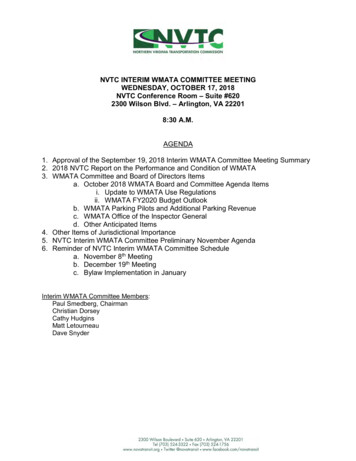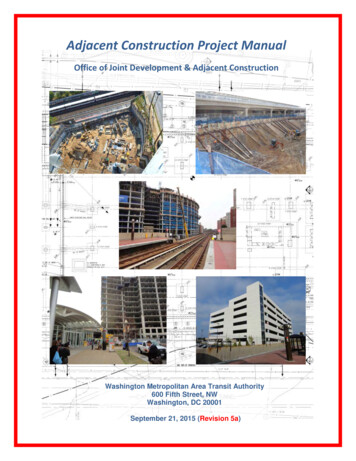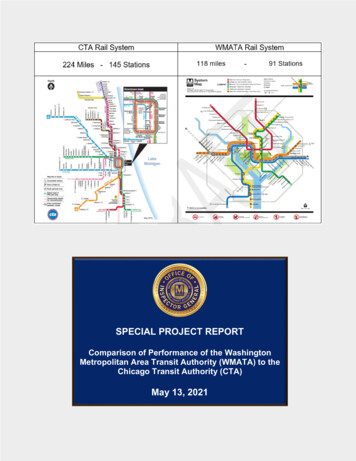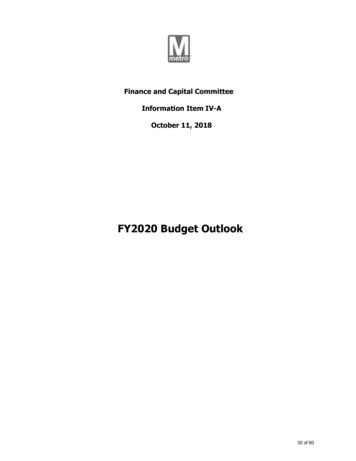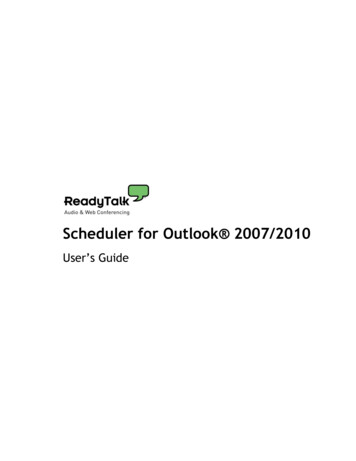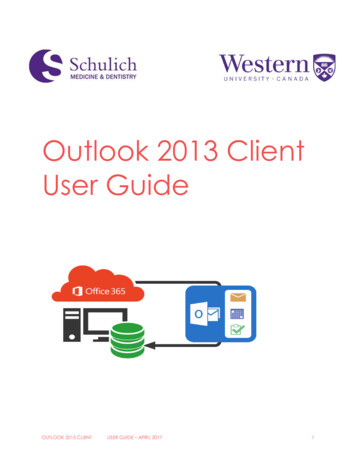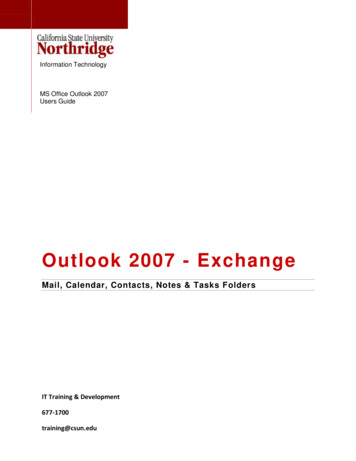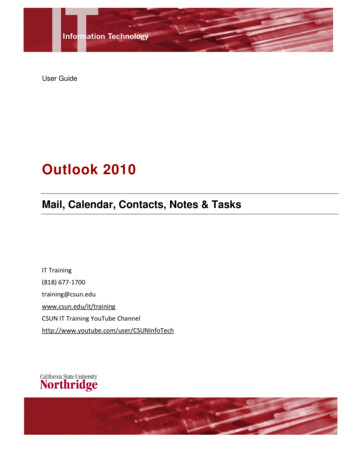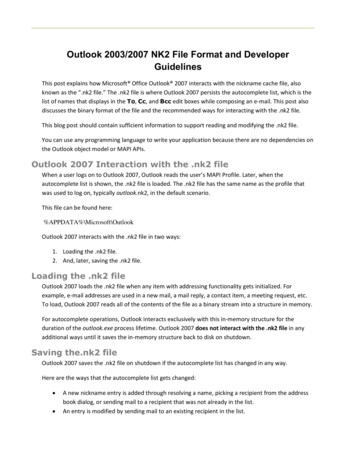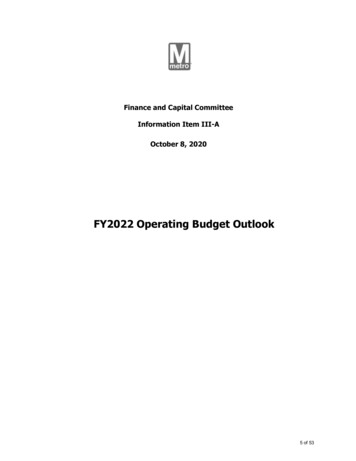
Transcription
Finance and Capital CommitteeInformation Item III-AOctober 8, 2020FY2022 Operating Budget Outlook5 of 53
Washington Metropolitan Area Transit AuthorityBoard Action/Information SummaryActionInformationMEAD Number:202213Resolution:YesNoTITLE:FY22 Outlook: Ridership and Revenue ScenariosPRESENTATION SUMMARY:Leadership will present several possible ridership scenarios for FY2022 and the resultingrevenue/subsidy impacts.PURPOSE:llReview ridership scenarios, revenue and expense projections for the FY2022 operatingbudgetSeek Board guidance on service and funding options for the FY2022 operating budgetDESCRIPTION:Identification of Parties with an interest in Metro’s budget:The following list includes Metro's top non-personnel multi-year contractors through FY2021and to date ( 500 million) as well as the Metropolitan Washington Airports Authority (MWAA).Some vendors have contracts spanning through FY2022 as well.lllllllllllllllllllKiewit Infrastructure CompanyKawasaki Rail Car Inc.PNC Bank National AssociationSunTrust BankC3M Power Systems, LLCTransdev Services, Inc.Gannett Fleming-Parsons Joint Venture IIMott MacDonald I&E, LLCNew Flyer of America, Inc.Bank of America NAWells Fargo Commercial ServicesClerk, U.S. CourtMotorola Solutions Inc.M.C. Dean, Inc.Mythics, Inc.Potomac Yard ConstructorsFirst Transit, Inc.Diamond Transportation Service, Inc.Dell Marketing LP6 of 53
llHNTB CorporationMetropolitan Washington Airports Authority (MWAA)A full list of Procurement Awards is available citations/index.cfm#main-contentMetro has labor agreements with the following collective bargaining units:lllllFraternal Order of Police/Metro Transit Police Labor Committee, Inc. (FOP)The Office and Professional Employees International Union Local No.2, AFL- CIO (Local2)Local 639, International Brotherhood of Teamsters Law Enforcement Division (Local 639)Local Union 689 of the Amalgamated Transit Union, AFL-CIO (Local 689)Local 922, International Brotherhood of Teamsters (Local 922)Key Highlights:lllllFY2022 ridership scenarios estimate that total ridership will recover 25 to 50percent of pre-Covid-19 levels.Covid-19 has heavily impacted Metro’s revenue, and will continue to into FY2022Revenues are estimated to be as much as 569 million below pre-Covid-19 levelsExpenses are continuing to grow due to contractual obligations and cost increasesMetro faces a funding gap that may reach 345 million in FY2022Background and History:In September, staff previewed an early outlook for the FY2022 operating budget as partof the Board’s deliberation on additional reductions needed in FY2021 to addressCovid-19 impacts and balance Metro's budget.The effects of the pandemic are expected to continue to impact the region throughFY2022 as Metro, like other transit operators, expects a lengthy recovery beforeridership and revenue return to pre-Covid levels.This presentation provides updated revenue and expense estimates to provide theBoard, and funding jurisdictions, an updated sense of the pandemic’s impacts onMetro’s FY2022 budget and the potential scale of the funding gap should the federalgovernment not provide a replacement for CARES Act funding, which Metro forecastswill run out in FY2021.Discussion:Current ridership scenarios estimate that the system will recover 25 to 50 percent ofpre-Covid-19 ridership levels. Despite the mild improvement in ridership outlook fromFY2021, the FY2022 funding gap is expected to be significantly larger due to severalfactors.In addition to the diminished ridership across the system, Metrobus continues to carrymore trips than Metrorail. A survey of Metrorail customers shows that 53% of former7 of 53
riders that are teleworking full-time would ride Metrorail again only when an effectivevaccine becomes available. The slower ridership recovery on Metrorail, particularlyduring peak hours, which typically are the greatest contributor to fare revenue, dampensMetro’s revenue outlook.Additional impacts and risks to the FY2022 Budget include increased Covid-19 cleaningand PPE expense and uncertainty around federal CARES Act funding, as well as othercost drivers such as employee benefit, insurance costs, contractually obligatedincreases from collective bargaining agreements, and ADA paratransit cost growth.While the proposed reductions to the FY2021 budget will result in savings in FY2022,the current service and management actions do not fully address Metro’s funding gapbased on the FY2022 ridership scenarios. The start of Silver Line Phase 2 revenueservice in FY2022 will also add to Metro’s expenses.Further actions will be needed to balance the budget, in light of a potential funding gapof 167 to 345 million. Additionally, should the funding jurisdictions not fully fund theFY2022 operating subsidy at its pre FY2021 one-time credit level, the gap would furtherincrease by 135 million.FUNDING IMPACT:Information item only - no funding impact.Project Manager: Dennis us ActionsSeptember 2020 – FY2021 Budget Update, FY2022 BudgetOutlook and Authorization for Public Hearing on FY2021 BudgetAmendment and Q3 Restoration of Metrobus Fare CollectionAnticipated actions after November 2020 – Presentation of the GM/CEO's proposedpresentationFY2022 budgetRECOMMENDATION:This is an information item. Budget adoption is scheduled for March 2021, which is necessaryto ensure uninterrupted regional funding of the capital program and to allow for the timelyapplication and award of Federal Transit Administration grants.8 of 53
FY2022 Operating Budget OutlookRidership and Revenue ScenariosFinance and Capital CommitteeOctober 8, 20201WASHINGTON METROPOLITAN AREA TRANSIT AUTHORITY9 of 53
FY2022 Operating Budget OutlookPurpose§ Review ridership scenarios, revenue and expense growthprojections for FY2022 Operating Budget§ Seek initial Board guidance on service and funding options forFY2022 Operating Budget2WASHINGTON METROPOLITAN AREA TRANSIT AUTHORITY10 of 53
FY2022 Operating Budget OutlookFY2021 Budget RecapFY21 Budget1FY21 Budget2FY21 Plan3Pre-Covid-19May 28, 2020Likely ScenarioRidership313.9150.661.0Revenue 823.7 385.9 178.7Expense 2,070.0 2,043.8 1,836.6Operating Deficit 1,246.3 1,657.9 1,657.9 546.3 546.3 1,111.6 1,111.6 and Trips in MillionsCARES ActSubsidy 1,246.31. FY2021 Budget Approved April 2, 20202. FY2021 Approved Budget, includes 546.3 million of CARES Act Funds3. Preliminary and is subject to Board approval of service changes and other factors3WASHINGTON METROPOLITAN AREA TRANSIT AUTHORITY11 of 53
FY2022 Operating Budget OutlookBus Continues to Carry More Riders than RailAverage Weekday Ridership1MetrorailMetrobusBus Service Improvements Service restored from 36% to 75% ofpre-Covid levels Weekday service improved on 174routes with most routes operating closeto normal Scheduled to resume front-doorboarding in January which will providemore capacity173K123K83K60KJulySeptember1. Ridership is preliminary, rounded for presentation purposes, and subject to revision4WASHINGTON METROPOLITAN AREA TRANSIT AUTHORITY12 of 53
FY2022 Operating Budget OutlookRail Peak Hours is the Greatest Contributor to FareRevenue but Is Recovering More SlowlyFare Revenue by ModeMetrorail Revenue by Time PeriodMetrobusWeekend 117.8M17%11%1%81%MetrorailOff-Peak Weekday25%64% 551.3MPeakMetroAccess 8.7M5Source: Budgeted Fare Revenue by Mode, FY2021 Original Budget (Pre-Covid-19); Metrorail Revenue by Time of Entry (FY2018-FY2019 Actuals)WASHINGTON METROPOLITAN AREA TRANSIT AUTHORITY13 of 53
FY2022 Operating Budget OutlookMetrorail Customer Retention and Ridership RecoveryTrends ThroughSeptember Work trips down 74% frompre-pandemic levels 62% of former riders areteleworking full-time and12% are unemployed Only 26% are now travelingto the workplace at leastone day a weekResults from survey conducted Sept 8-15th of1,100 customers who rode Metrorail towork before the pandemic6Outlook Through the Endof 2020 Only 6% of pre-pandemiccommuters expect to rideMetrorail to work more often Only 2% of full-timeteleworkers are certain toreturn their workplaces viaMetrorail before next year Of those now traveling towork some days of theweek, only 4% are certainto travel more often to theirworkplaces via Metrorailbefore next yearWASHINGTON METROPOLITAN AREA TRANSIT AUTHORITYEffective Vaccine Key toRegain Ridership 53% of former riders thatare teleworking full-timewould ride Metrorail againonly when effectivevaccine available Of those commuting towork some days but notriding Metrorail, 48% wouldride Metrorail again onlywhen effective vaccineavailable14 of 53
FY2022 Operating Budget OutlookRidership Scenario AssumptionsArchetypeVirusHighMediumLowContained resurgence in FY22Pockets of spread in early FY22Wide-spread resurgence in FY22Vaccine Available FY21Vaccine Available early in FY22Vaccine Not Available Until late FY22Wary/High Vaccine AcceptanceScared/Some Vaccine AcceptanceFear/Low Vaccine AcceptanceLowReturn in late FY21LowReturn in Late FY21Low Q1-Q4Slow reopening in FY22Low to Medium in FY22Low to Medium in FY22Low until FY23High telework for FY22Higher telework for FY22Persistent telework beyond FY22In-person reopening throughout FY22Gradual In-person reopening in FY22 withEmphasis on Virtual LearningPrimarily Virtual Educationthroughout FY22Steady increase in FY22Steady increase in FY22Work from home beyond FY22Low impact to DMVModerate impact to DMVHeavy impact to DMVReduced capacity in FY22Reduced capacity in FY FY22Limited capacity beyond FY22VaccineRider SentimentTrips- Work- Leisure- TeleworkRegional Economy- School- Federal Government- Employment1- Special events1. Source: Based on the Bureau of Labor Statistics trend7WASHINGTON METROPOLITAN AREA TRANSIT AUTHORITY15 of 53
FY2022 Operating Budget OutlookRidership Recap and FY2022 Scenarios100M79M80M78MCOVID-19 Impact 26%64M60M 38% 10%40M 29% 26% 17% 29% 16% 17%-5%High50% RestoredMedium40% Restored-8% 0%Low25% Restored20M10M20M14M15MFY20FY21FY21Q4Q1Q2Likely Budget 2.4M33.9M18.1M53.4M42.7M20.9MFY2022 ScenariosHighMediumLowWASHINGTON METROPOLITAN AREA TRANSIT AUTHORITY28.3M22.6M20.5M157.0M125.6M78.5M16 of 53
FY2022 Operating Budget OutlookFare Revenue Recap and FY2022 Scenarios 180M 171M 168M 26%COVID-19 Impact 160M 140M 29% 138M 17% 120M 37% 100M 17% 10% 29% 26% 19%-3%Medium40% Restored-9%-1% 80MHigh50% Restored 60MLow25% Restored 40M 44M 7M 20M 21M 25MFY21Q1FY21Q2 32M y Budget Scenario1FY22Q1FY22Q2FY22Q3FY22Q4FY2022 ScenariosFareRevenueHighMediumLow 61.0M 48.8M 44.2M 71.2M 56.9M 40.2M 91.5M 73.2M 38.9M 115.2M 92.2M 46.2M 338.9M 271.1M 169.4M1. Likely Budget Scenario updated to reflect Board approval of bus fare collection restoration beginning in January 20219WASHINGTON METROPOLITAN AREA TRANSIT AUTHORITY17 of 53
FY2022 Operating Budget OutlookRidership and Revenue ScenariosFY22 Ridership ScenariosFY21 BudgetFY21Pre Covid-19Proposed Plan314HighMediumLow6115712678 678 117 339 271 169Parking 45 9 22 18 11Advertising 36 6 18 14 9 758 131 379 303 189 and Trips inMillionsRidership TripsRevenue FaresTotal11. Excluding joint development, fiber optics and other revenues10WASHINGTON METROPOLITAN AREA TRANSIT AUTHORITY18 of 53
FY2022 Operating Budget OutlookAdditional Financial ImpactsCollective Bargaining AgreementCovid-19 Uncertainty around CARES Act fundingAdditional PPE Cleaning CostsPersonnel TestingAdditional Health Programs Contractually obligated increasesADA Paratransit Growing demand from aging population Continued contractor cost growthOperational Increases 11Contracted ServicesEmployee BenefitsOperationalizing Capital ProjectsInsurance CostsSubsidy Growth FY2021 Subsidy Credit Add-back In-source Cinder Bed Road Garage Silver Line Phase 2 Credit Add-backWASHINGTON METROPOLITAN AREA TRANSIT AUTHORITY19 of 53
FY2022 Operating Budget OutlookFY2022 Service and Fare AssumptionsFY2021 NovemberBoard ConsiderationFY2022AssumptionWeekday rail service frequency of 12 minutes on each lineüüReduced number of trains/operators byshortening trips where possible (i.e. ull YearMetrorail Red Line: Every other trip Grosvenor-Silver Spring Yellow Line: All trips begin/end at Mt. Vernon SquareShortened span of service by 10 hours/weekClose at 9 pm Sun-Thu (retain 11 pm Fri/Sat)Silver Line Phase 2 Opening July 1MetrobusBus - Retention of August Service PlanRestore Bus Fares in FY2021 Q312WASHINGTON METROPOLITAN AREA TRANSIT AUTHORITY20 of 53
FY2022 Operating Budget OutlookProjected funding Gap could reach 345 MillionFY22 Ridership ScenariosHighMediumLowRestore One-time Subsidy Credit 135 135 1353% Annual Subsidy Growth Cap 37 37 37Revenue Growth 250 174 60CARES Act Loss( 546)( 546)( 546)Subtotal( 124)( 200)( 314)Expense Growth¹( 81)( 81)( 81)Silver Line Phase 2 Revenue Service2( 45)( 47)( 50)( 251)( 329)( 445) 84 91 100( 167)( 238)( 345) in millionsTotal Funding GapFY2021 Continued Service Changes3Final Gap1. Includes One-Time Management Credit for Silver Line Phase 2 totaling 36.5M , 2. Assumes 10M, 8M and 5M of revenue respectively3. Does not include additional Silver Line Phase 2 reduction13WASHINGTON METROPOLITAN AREA TRANSIT AUTHORITY21 of 53
FY2022 Operating Budget OutlookPreliminary Base Subsidy by JurisdictionFY2021EffectiveSubsidy 399One-TimeCredit AddBack 49 184 22 206 6 212 28 241 30 270 8 278 38 424 52 476 14 490 66City of Alexandria 46 6 52 2 53 7Arlington County 77 9 86 3 89 12 3 0 3 0 3 0 154 18 172 5 177 24City of Falls Church 3 0 4 0 4 0Loudoun County 5 0 6 0 6 1 288 34 322 10 332 44 1,112 135 1,246 37 1,284 172 in MillionsDistrict of ColumbiaMontgomery CountyPrince George'sCountyMaryland SubtotalCity of FairfaxFairfax CountyVirginia SubtotalTotal ContributionFY2021Approved 3% SubsidyFY2022Subsidy Growth Cap Base Subsidy 448 13 461Change 62Note: Illustrative purposes only based on FY2021 allocation; FY2022 jurisdictional allocation subject to final Board approval of bus and rail service changes14WASHINGTON METROPOLITAN AREA TRANSIT AUTHORITY22 of 53
FY2022 Operating Budget OutlookPublic Outreach for FY2022 Budget§ Title VI analysis and public outreach begins January with notice of hearingand docket§ Public outreach consistent with coronavirus health protocols, supplementedwith virtual and online public comment§ Calendar to include time for additional equity analysis as needed toevaluate options and mitigations§ Subject to Board consideration and approval, docket may include: 15Service and Fare proposalsProposed operating budgetProposed capital investments and grant applicationsWASHINGTON METROPOLITAN AREA TRANSIT AUTHORITY23 of 53
FY2022 Operating Budget OutlookKey Dates and MilestonesMILESTONESFY22 Ridershipand GM/CEO FY22ProposedBudget16Board BudgetAdoptionPublicHearings &OutreachJanBoardDiscussionsWASHINGTON METROPOLITAN AREA TRANSIT JulSubmitFederalApplications24 of 53
FY2022 Operating Budget Outlook FY2021 Budget Recap 1. FY2021 Budget Approved April 2, 2020 2. FY2021 Approved Budget, includes 546.3 million of CARES Act Funds 3. Preliminary and is subject to Board approval of service changes and other factors FY21 Budget1 FY21 Budget2 FY21 Plan3 and Trips in Millions Pre-Covid-19 May 28, 2020 Likely Scenario
